Asaf Peres
The Chainsmokers ft. Halsey - "Closer": Crafting the Chorus
In 2016, then-rising-stars The Chainsmokers and Halsey released "Closer", which became not only one of the biggest smash hits of the year, but of this entire decade. It topped the Billboard Hot-100 chart for 12 consecutive weeks (!), in large part thanks to its incredibly infectious chorus.
'On paper', this chorus seems very simple. And it is--but it is also extremely crafty. The songwriters of "Closer" created a perfect blend of repetition and variation, making it very memorable and easy to get hooked on.
I mean, listen for yourselves (chorus starts at ~0:51):
In order to really understand what happens under the hood of this chorus, it's a good idea to first look at the elements of repetition and then see how they are tweaked to create variation.
REPETITION ELEMENTS
The songwriters of "Closer" went with a very minimalistic approach in writing the vocal melody of the chorus. These are the main repetition elements:
Repetition Element #1 - There are only three unique notes in the entire section: Ab, Bb, C (or scale degrees ^1, ^2, ^3 in the Key of Ab-Major).
Repetition Element #2 - Rhythmically, the melody is made up entirely of a continuous string of 8th notes, with only a couple of 8th rests in the middle.
Repetition Element #3 - The chorus contains an 'anchor fragment'--a string of three notes that repeats relentlessly and accounts for more than two thirds of the section.
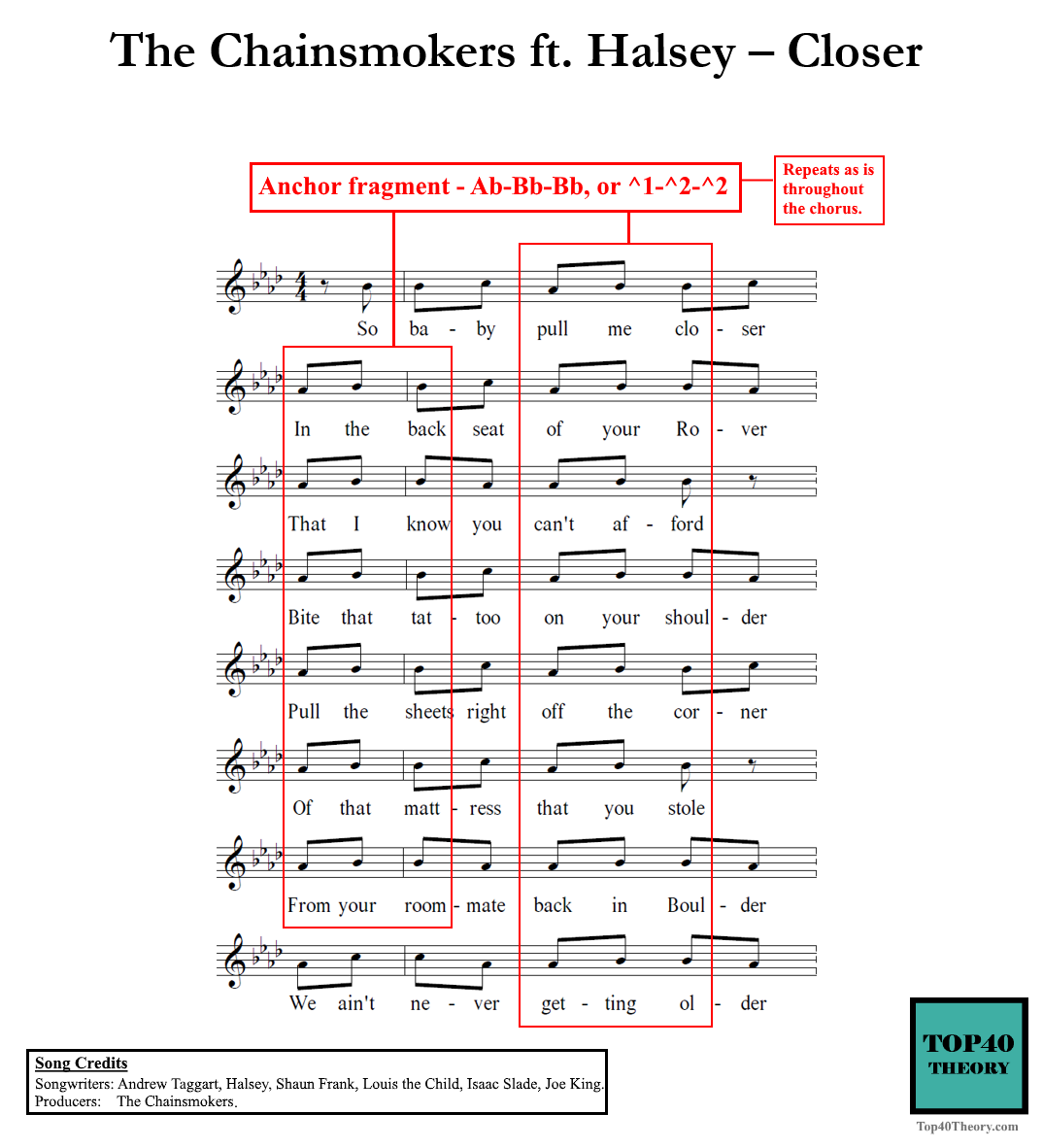
VARIATION ELEMENTS
The repetition elements I listed above take up so much real estate in the chorus that, at least on paper, it seems like we're entering 'overly repetitive territory'.
But a few perfectly timed variations give this chorus a musical story arc that takes the main stage and moves the repetitions into the background.
Variation Element #1 - Tweaking the Anchor Fragment
The anchor fragment I mentioned above is tweaked twice, and each of these tweaks serves an important function.
The first tweak happens at the very beginning of the chorus, before we even hear the full fragment. The first note of the anchor fragment (Ab) is omitted, making the first phrase both start on Bb instead and in a different metric position (an eighth later than all other phrases).
This is important because it prevents the anchor fragment from setting the tone of the chorus. To a degree, it obscures the repetitive nature of this fragment and allows it to serve as a background canvas over which the variations are painted.
As an ear training exercise, try to imagine the chorus starting with the complete fragment rather than the truncated version. How much more aware do you become of its repetitions? I know that for me it would change the entire experience.
The second tweak of the anchor fragment happens at the beginning of very last phrase. The two B-flats are raised by a step and become Cs.
After so many consecutive exact repetitions, this is very noticeable and works to enhance the function of the final phrase as the final--and strongest--melodic cadence of the chorus.
In fact, Shaun Frank--who co-wrote this song--confirmed to me that they saved those Cs in order to get a strong conclusion to the chorus.
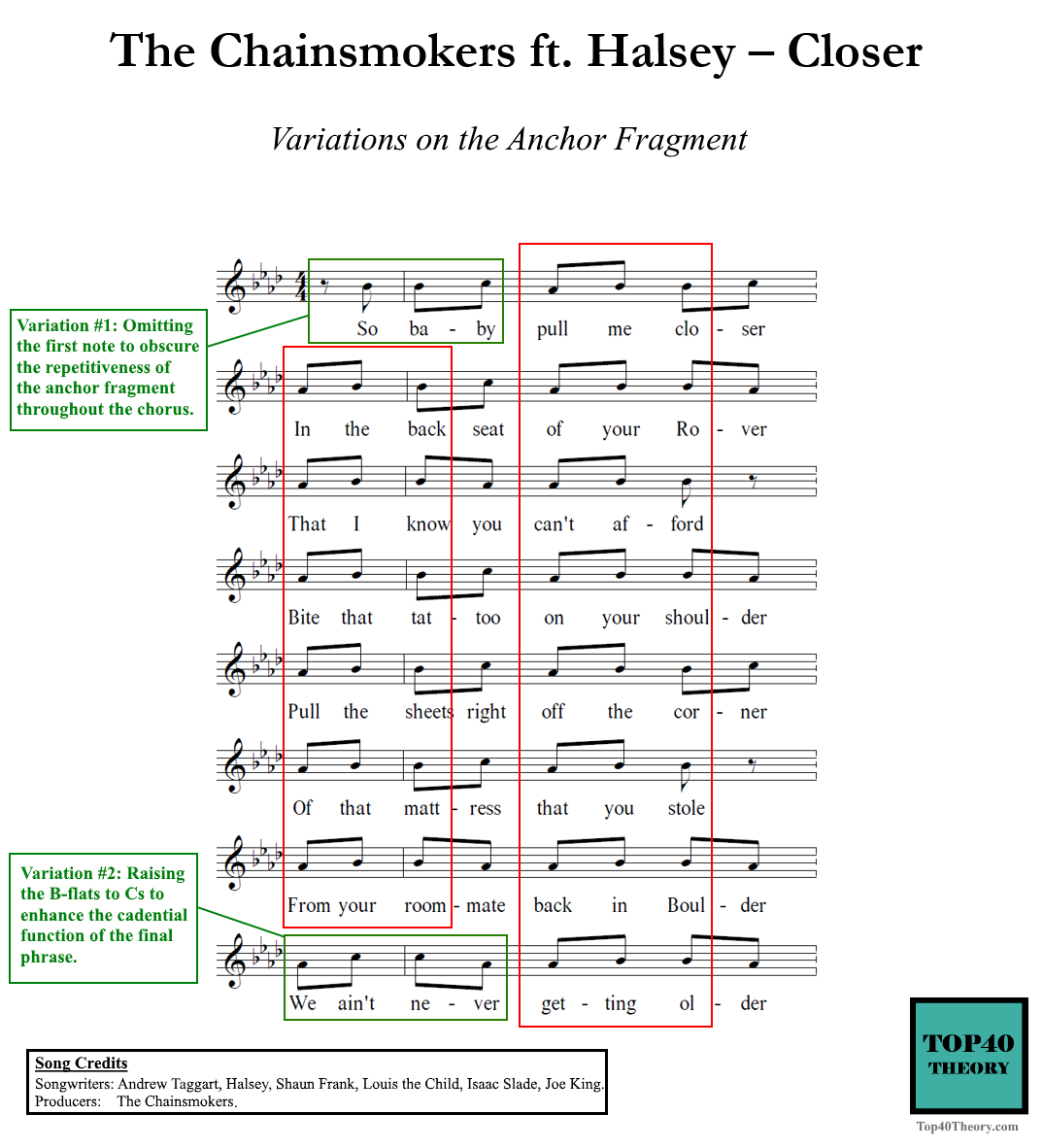
Variation Element #2 - Creating Structure
Every instance of the anchor fragment, which ends on a Bb, or ^2, is followed by either a C (^3), an Ab (^1), or a rest.
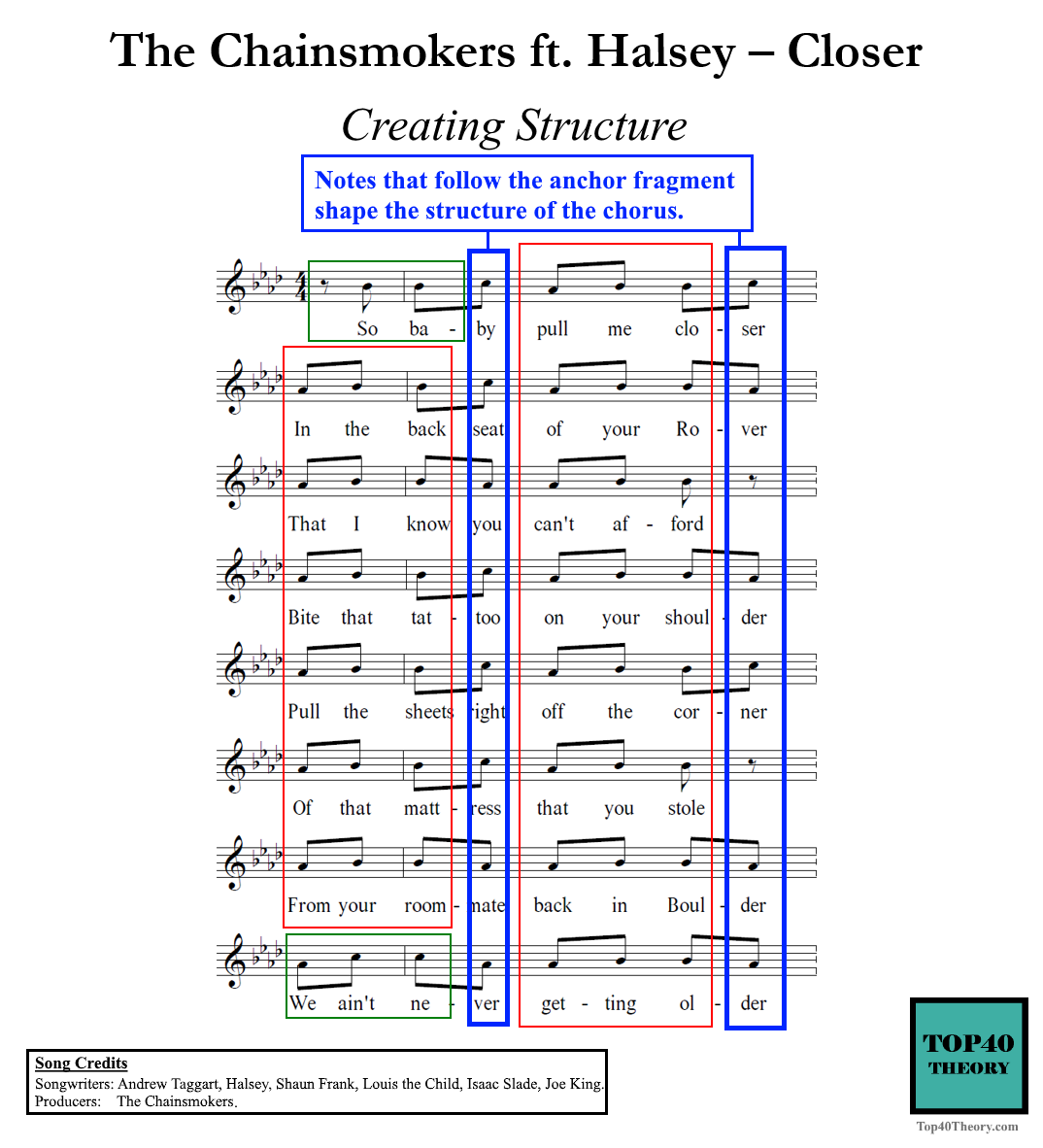
Why is this an important detail? Because out of the three scale degrees used in this chorus, ^2 is the most unstable, and each of the notes that follow it produces a different effect (in conjunction with its metric placement):
- Going from ^2 to ^1 is the most stable resolution, and is used to create cadences at strategic spots.
- ^3 is also a stable tone, but not as stable as ^1. Going to it creates an internal resolution while still maintaining a continuation of a phrase or group of phrases.
- Following the anchor fragment with a rest creates a space that carves out a secondary phrase groupings (I will elaborate on this later), while leaving ^2 unresolved and amping up tension.
The notes that follow the anchor fragments--especially at the end of each phrase--create a sequence of progressively intensifying cadences.
Think of the last notes of each phrase as a high-level structural melody that encapsulates the sequence of cadences.
The first half of the chorus features two cadences (I like to think of it as two brush strokes). The first is milder than the second, because the tension-release effect of a ^3-^1 sequence is not as potent as that of a ^2-^1.
The second half of the chorus features one long brush stroke--a drawn-out cadence that includes a ^3-^2-^1-^1 sequence, with the first ^1 being only a preview of the resolution due to its metric position, and the second ^1 being the 'real' resolution, made even stronger by the Cs in the tweaked anchor fragment that I mentioned earlier.
And as a bonus, the final phrase is also a condensed/intensified version of the higher-level cadential sequence in the first half.
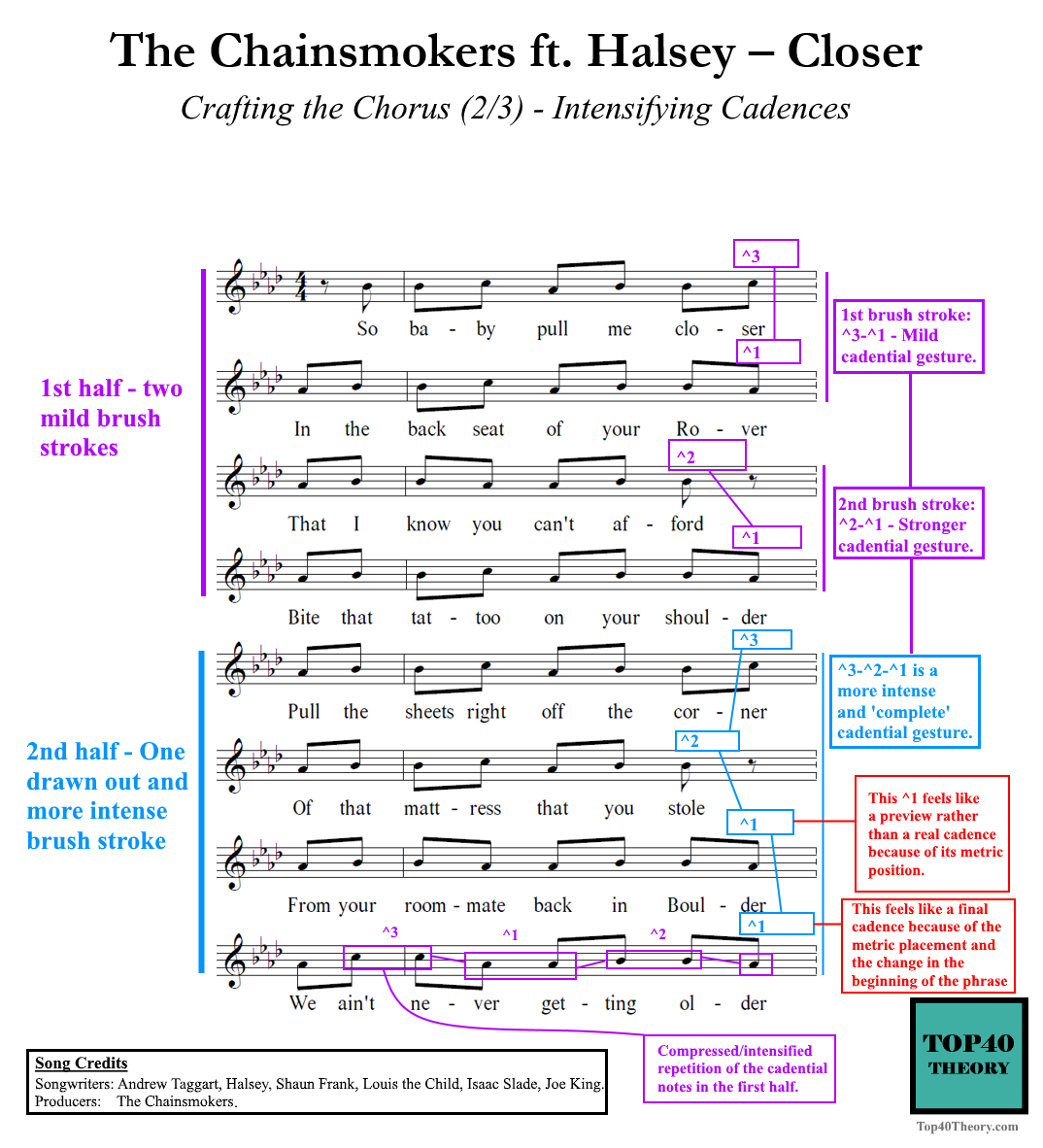
Variation Element #3 - 'Syncopated' Phrase Groupings
Remember when I mentioned that the two rests in middle of the chorus carve out a secondary phrase grouping? Well, now is the time to explain this.
I just illustrated how the chorus is divided into two halves, one consisting of two brush strokes and the other of one brush stroke that is more drawn out and intense. That is the primary phrase grouping of the chorus--4+4 phrases--which sets the large-scale straight rhythm, sort of like a 4-on-the-floor kick drum can do for a dance beat.
But just like the 4-on-the-floor will usually have syncopated percussive elements hitting against it and pushing the energy, the chorus structure in "Closer" has a secondary phrase grouping--specifically a 3+3+2 grouping--that creates a large-scale sense of syncopation.
But just like the 4-on-the-floor will usually have syncopated percussive elements hitting against it and pushing the energy, the chorus structure in "Closer" has a secondary phrase grouping--specifically a 3+3+2 grouping--that creates a large-scale sense of syncopation.
This secondary grouping is defined by three things:
The rests at the end of the 3rd and 6th phrases - While there are no tonal cadences at the ends of these phrases, these rests provide a rhythmic cadence that helps create this secondary grouping.
The unresolved ^2 (Bb) at the end of these same phrases - While the unresolved ^2 amps up the tension within the tonal sequence, the fact that this tension comes uniquely in conjunction with the rests helps to give more definition to the secondary phrase grouping.
The rhyme scheme - Outside of the 3rd and 6th phrases, all phrases in this chorus end on the 6th eighth note of the measure and rhyme with one another. But notice that the syllables on the 5th eighth note on every measure also rhyme with each other (though these are soft rhymes). This allows phrases #3 & #6 to have their own internal rhyme scheme while not disrupting the overall flow of the song.
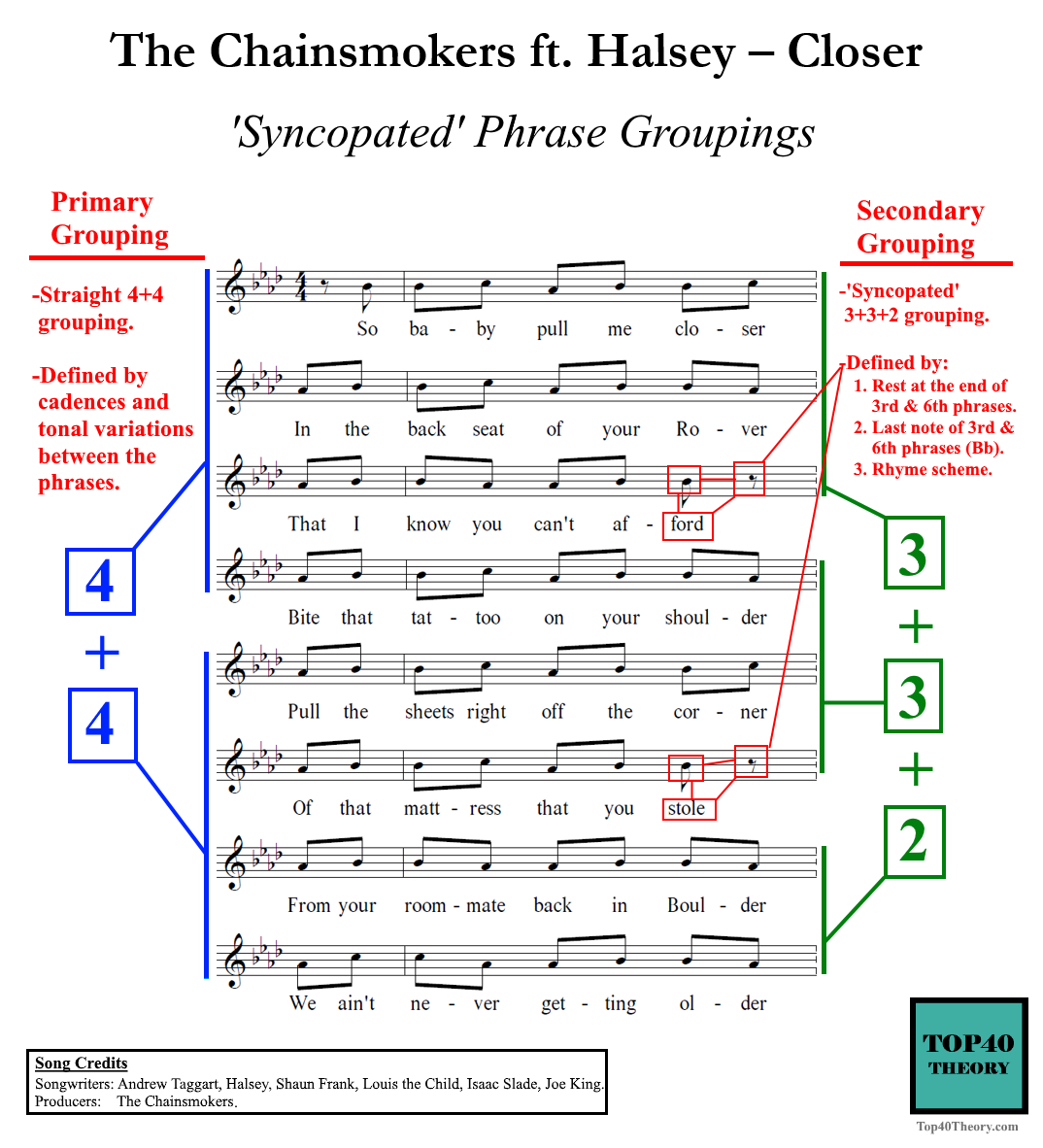
Large-scale syncopation like this is different from surface-level syncopation that's designed to make your body move on the dance floor, but it does a lot for the flow of this chorus, obscuring the repetitive elements even more and creating another level of interest.
CONCLUSION
I don't believe that a 'formula' exists for creating hits, but one very general rule that applies to nearly every hit song is that a level of familiarity needs to be created through repetition, and that needs to be balanced with enough variation to make the song sound unique and engaging, and help it stand out among numerous other songs that try to hook us.
The creators of "Closer" did a masterful job at achieving both by combining three distinct repetition elements...:
- Limiting the melody to 3 notes.
- Using only a single rhythmic value.
- Creating an anchor melodic fragment.
...with three distinct variation elements:
- Strategic tweaks to the anchor fragments.
- Using the notes that follow the anchor fragments to create a tonal arc.
- Creating a syncopated secondary phrase grouping.
To be clear, by analyzing this chorus I am not trying to recreate the songwriters' thought process. Most of these things are done intuitively as a result of experience and trial & error.
But looking under the hood and seeing how the different elements in this chorus work together to create what was one of the biggest hits of the decade can be a fantastic learning experience for any pop musician. I know it was for me.
Final note:
I mentioned that the song is in Ab-major, but it's certainly possible to hear it in the relative F-minor because the chord progression, and especially the bass line, keep coming back to F. However, even if you hear the song in F-minor, the melodic cadences I detailed still apply, because in modern pop the melody often operates independently of the harmony, and many songs that are primarily in minor but use only the natural minor mode (i.e., no harmonic/melodic minor inflections) still treat the melody as if it was in the relative major, including cadential resolution to ^1 of that relative major.
There's a lot more nuance to this, but this will have to wait for another post.
"Closer" Song Credits
Songwriters: Drew Taggart, Halsey, Shaun Frank, Louis the Child, Isaac Slade, Joe King.
Producers: The Chainsmoker.
Top40 Theory Email List
Submit your email to receive important announcements about new courses and content from Top40 Theory
Thank you!
Copyright © 2022

